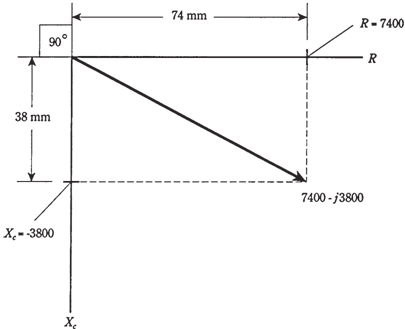Determine the lead:
If you know ratio of capacitive reactance to the resistance, or XC /R, in the RC circuit, then you can find phase angle. Certainly you can find this angle of lead if you know precise values.
Pictorial method
You can use the protractor and the ruler to find phase angles for the RC circuits, just as you did with the RL circuits, as long as the angles are not too close to 0 or 90 degrees.
Draw the line first somewhat longer than 10 cm, going from left to right on paper. Then, use protractor to the construct a line going somewhat more than 10 cm vertically downwards, starting at left end of horizontal line. The horizontal line is R axis of a crude RC plane. The line going down is XC axis. If you know values of XC and R, divide or multiply them by the constant, chosen to make both the values fall between 100 and 100. For example, if XC = -3800Ω and R = 7400 Ω, divide them by 100, getting -38 and 74. Plot the points on the lines as hash marks. The XC mark goes 38 mm down from intersection point between your 2 axes. The R mark goes 74 mm to the right of intersection point.
Now, draw the line connecting the 2 hash marks, as shown in the Figure given below. This line will be at slant, and will form a triangle along with the 2 axes. This is a right triangle, with right angle at the origin of RC plane.

Figure-- Pictorial method of finding phase angle.
Measure the angle between slanted line and R, or the horizontal axis. Use the protractor for this. Extend lines, if required, using the ruler, to get a good reading on the protractor. This angle will be in between 0 and 90 °. Multiply this result by -1 to get RC phase angle. That is, if protractor shows 27 °, RC phase angle is 27 °.
The actual vector is found by constructing a rectangle by using the origin and your 2 hash marks, making new perpendicular lines to complete the figure. The vector is diagonal of this rectangle, running out from origin. The phase angle is angle between R axis and this vector, multiplied by -1. It will have same measure as angle of the slanted line you constructed in the figure given below.

Figure-- Another pictorial way of finding phase angle. This method shows the actual impedance vector.